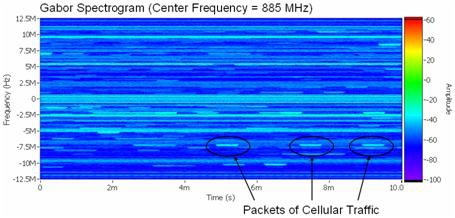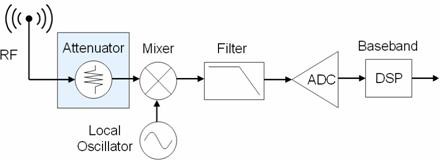Terabyte RF Instrumentation: Solving New Applications with High-Speed Storage Solutions
Overview
Contents
Introduction
Traditional RF instruments such as vector signal generators and vector signal analyzers use standard RAM (Random Access Memory) as a mechanism for waveform storage. As a result, maximum generation and acquisition sizes for these RF instruments are typically limited to several hundred megabytes at best.
However, the combination of a high-speed data bus and RAID technology enables longer acquisition rates. Moreover, for RF signals, an RF analog front end and digital signal processing technologies enables efficient generation and acquisition of signals using superheterodyne upconversion and downconversion. A high-level system diagram of a typical system is illustrated in the figure below.
Figure 1: Several core technologies enable RF stream-to-disk.
As a result of each of these components, instrument memory can be supplemented with high-speed RAID (Random Array of Inexpensive Disks) hard drive configurations. In this scenario, data can be transferred from the instrument to hard disk at rates that exceed the rate of acquisition. Thus, the maximum waveform size is no longer limited by size of onboard memory, but by the size of available hard disk space. Using external RAID hard drive configurations, the waveform storage can be expanded to up to several terabytes of data. For more information on the technology that enables RF Stream-to-Disk systems, see: From RF to RAID: Enabling Technologies of RF Stream-to-Disk Systems.
Overview of RF Stream-to-Disk Applications
The ability to generate or acquire up to several terabytes of continuous data enables PXI instruments to solve new applications that were once only possible with custom hardware. In this paper, we will describe four common applications which significantly benefit from the use of sustained continuous RF generation or acquisition. These applications are:
- Spectrum Monitoring
- Packet Sniffing
- Wireless Receiver Design, Validation, and Verification
- Digital Video Broadcast BER Tests
In each of the applications listed above, the ability to continuously stream data to disk for extended periods of time is either essential, or provides substantial benefits.
Spectrum Monitoring
Signal intelligence describes a broad range of applications ranging from communications jamming, identification of interference signals, and even packet sniffing. Spectrum monitoring is a subset of this application and it involves identification of interference signals within a particular bandwidth of interest. Spectrum monitoring applications significantly benefit from RF stream-to disk systems because of the “bursty” nature of many interference signals. While these signals can often be visualized on a spectrum analyzer or even a real-time spectrum analyze, accurate analyze required continuous RF acquisition for extended periods of time.
By acquiring long durations of RF bandwidth, engineers are provided with a rich set of data to post-process with several analysis techniques. For example, it is common to use custom FFT sizes to characterize the amplitude of pulsed information. In addition, modulation analysis can also be performed to identify the modulation scheme and message information of an interference signal.
However, perhaps the most interesting type of analysis used in spectrum monitoring applications is the Gabor Spectrogram. This type of joint time-frequency analysis enable user to characterize changes in both amplitude, duration, and frequency of interference singals.
The Gabor Spectrogram operates by performing a series of FFTs on subsequent time-domain sections of waveform. The processed data can be easily visualized on a 3D waterfall graph, shown below.
Figure 2: Joint time-frequency analysis using the Gabor spectrogram.
As the figure illustrates above illustrates, the Gabor spectrogram enables us to visualize both the time and frequency information of a given RF bandwidth. In figure 2, we used an IQ rate of 25 MS/s at a center frequency of 885 MHz to monitor a cellular broadcast band. As the waterfall graph illustrates, this display to observe when a particular cellular band is being utilized, and when it is not. Each “packet” of cellular data appears as higher-amplitude portion of the graph. From the graph above, we can see that each packet is about 1ms in duration and occurs at amplitudes as high as -30 dBm.
As the example of the spectrogram illustrates, spectrum monitoring applications significantly benefit from the ability to continuously acquire waveforms for long periods of time. While the figure above only shows 10 ms of data, today’s PXI RF stream-to-disk systems can store up to 20 MHz of RF bandwidth for 5+ hours. Thus, the same cellular band shown above could be monitored to enable identification of any interference in the band of interest. For more information on tips and techniques for signal intelligence applications.
Packet Sniffing a Communications Channel
A second type of interference signal is the “piggybacking” communication signal. In this application, an interfering signal actually attempts to use the existing telecommunications infrastructure to transmit an illegal communications channel. As an example, an illegal transmitter might attempt to use a repeater tower to repeat re-broadcast his custom communication channel. Because the repeater simply amplifies a specified band of spectrum, the interferer can use it to amplify his signal as well as the intended channels.
Again, “packet sniffing” a given signal can be accomplished by recording a specified bandwidth and storing it to disk. Once captured, this data can be post-processed through a variety of mechanisms. Just as with analysis of jamming signals, post analysis such as FFT and JTFA can be performed to identify frequency, power, and amplitude information about the interference signal. However, for “packet sniffing,” applications, it is common to demodulate the baseband waveform as well. This is illustrated in the figure below:
Figure 3: Analysis of baseband waveforms using the modulation toolkit.
In the figure above we can see that baseband waveforms that have been stored on hard disk can be analyzed using one of many demodulation subroutines in LabVIEW. Figure 6 shows the icons for the PSK, QAM, FSK demodulation routines from the LabVIEW Modulation Toolkit. However, note that the LabVIEW modulation toolkit also offers routines for ASK, FM, AM, PM, CPM, MSK, and custom demodulation. Note that demodulation of an unknown carrier is not trivial. In order to accurately return, the bitstream of a digitally modulated carrier, it is important to know the symbol rate of the carrier. While this can be estimated by observing the channel width, it must often be determined experimentally by using symbol rates of known communication standards.
By demodulating the communications signal of an interference signal, we are able to analyze the individual bitstream being transmitted over the communication channel. In some cases, this information can be decoded by matching it with known preamble information. However, in many cases, the greatest challenge is in decoding meaningful information out of a bitstream of data.
RF Record and Playback for Wireless Transceiver Validation
A third application for RF stream-to-disk systems is their use as RF record-and-playback hardware is design validation and verification of wireless receivers. The wireless environment is an inherently non-idea communications channel susceptible to challenges such as signal strength degradation, multi-path channel fading, and interference from interfering carriers. As a result design validation and verification of today’s wireless receivers requires their performance to be characterized under a wide variety of operating conditions.
In the past, receivers were commonly tested highly elaborate with “dirty transmitter” waveforms which simulated parameters such as additive white Gaussian noise (AWGN) and Raleigh multi-path channel fading profiles. However, producing accurate RF environment models is difficult, and nothing can substitute for the real thing. Thus, simulation models can often be replaced with “perfect” simulations that have been recorded using a vector signal analyzer. In this scenario, a vector signal analyzer is used to acquire a particular RF bandwidth. The signal is then regenerated in a laboratory environment with a vector signal generator. In this case, the use of recorded RF bandwidth enables the introduction of natural impairments and provides a more accurate characterization of how the receiver will perform in its final environment.
One common test that can be performed with a “perfect simulation” waveform is a receiver sensitivity test. In this test, the RF signal strength is quickly adjusted to simulate typical wireless conditions. The wireless receiver, using automatic gain control, accounts for fluctuations in signal strength by amplifying or attenuating the incoming RF signal. Below, we illustrate the attenuation stage with a simplified block diagram of a Low-IF wireless receiver.
Figure 4: Block diagram of typical RF receiver
For the test described, we can characterize the receiver’s sensitivity to a wide variety of environmental conditions over a long period of time using recorded RF spectrum as the stimulus. In addition, we can use the same waveform over and over again to characterize how every iteration of a prototype receiver responds to the same environmental conditions.
While the wireless environment provides inherent challenges to communications channels, these challenges can be ideally presented to a receiver with recorded RF bandwidth. As a result, prototyping next generation receivers can now be accomplished with greater efficiency, accuracy, and repeatability than was previously possible.
Broadcast Digital Video Test
A final application that significantly benefits from RF stream-to-disk systems is digital video broadcast test. Historically, testing of analog broadcast video only required static test patterns. However, today’s digital video broadcast video standards (such as DVB) use complex image decompression and decoding algorithms to account for errors in the wireless channel. Thus, testing today’s DVB set-top boxes requires generation of moving video patterns.
The most common test is a pixilation test, where a moving video pattern is generated using a vector signal generator. Because pixilation only occurs with moving pictures, detecting these bit errors requires acquisition of the digital transmission for several seconds or even minutes at a time. In the figure below, you can see the effects of pixilation on a digital image.
Figure 5: Pixilation Occurs As a Result of Transmission Error
Using RF stream-to-disk systems, these patterns are no longer limited to several hundred megabytes. Instead streaming the broadcast waveform from disk enables extended bit error rate (BER) testing of broadcast video set-top boxes.
Conclusion
The ability to stream RF signals to and from hard disk for extended periods provides a revolutionary and yet cost-effective approach to waveform storage. While waveform generation and acquisition sizes were traditionally limited by the size of onboard RAM, new bus and disk technology enables several terabytes of waveform storage. As a result, many new applications from spectrum monitoring to broadcast video test are now possible using commercial, off-the-shelf, hardware. For more information on RF instruments and RF stream-to-disk applications, please visit one of the links below:




